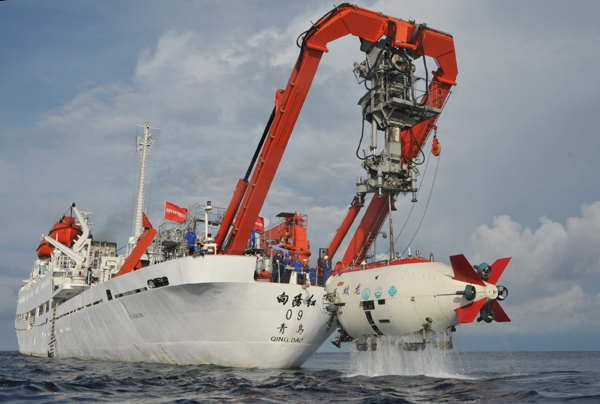

Further exploration missions scheduled for Jiaolong next year.
 |
|
The carrier boat Xiangyanghong-09 hoists the manned deep-sea submersible, jiaolong, in this July 3, 2013 file photo. [Photo/Xinhua] |
"We will acquire geological data, conduct a mineral resource survey and assess biodiversity in these regions during the two missions, preparing for future exploration and mining," Liu Feng, director of the National Deep Sea Center, said in an exclusive interview.
He said Xiangyanghong 09, the mother ship of Jiaolong, will start a 40-day journey to the northwest Pacific in May and then to the southwest Indian Ocean in November for 40 or 50 days.
The China Ocean Mineral Resources Research and Development Association won exclusive rights to explore for cobalt crusts in the western Pacific in July and also a polymetallic sulphide contract in the southwest Indian Ocean in 2011.
Cobalt crusts are rich in iron and hydroxide deposits containing significant concentrations of cobalt, titanium, nickel, platinum, molybdenum, tellurium, cerium and other metals and rare earth elements.
Polymetallic sulphides contain base metals that include copper, lead and zinc, as well as gold and silver.
"As we promised in the contracts, we will conduct research and surveys there and report our analysis and observation data to the International Seabed Authority," Liu said.
Jiaolong dived in the northwest Pacific in September and recorded "great achievements" in deep-sea bio-diversity and deposit distribution, Liu said.
During the dives this year, scientists observed that large sea creatures live at different depths and areas, which means mining in deep-sea area will not cause large-scale extinction of species.
"The observation will help the International Seabed Authority in drawing up rules and regulations for future exploration and mining," Liu said, adding that China is not exploring deep-sea areas for itself, but for the world.
Wang Chunsheng, a professor at the Second Institute of Oceanography who attended the dive project in the Pacific, said clarifying the bio-environment will help protect bio-diversity in the ocean depths and assess the potential environmental impacts during future mining.
Zhou Huaiyang, a professor at Tongji University's School of Ocean and Earth Science, took Jiaolong on a dive in the South China Sea in June and said he never thought that deep-sea creatures were so active. He said he saw many for the first time in his life.
Liu said, "The dive project in the northwest Pacific next year will achieve a more comprehensive survey and research in the contract areas."
Although a latecomer to deep-sea exploration, China has achieved great success after the International Seabed Authority authorized its exploration of polymetallic nodules in the northeast Pacific in 2001.
China is authorized to explore the international seabed for three major types of minerals — polymetallic nodules, polymetallic sulphide deposits and cobalt crusts.
The National Deep Sea Center, home of Jiaolong, started port construction in early November. This is expected to be finished by the end of 2014. Investment reached about 500 million yuan ($81 million). "Deep-sea technologies and equipment are entering a booming age of development," Liu said.
Contact the writer at wangqian@chinadaily.com.cn